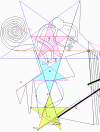|

The Cone & Square & the
Nasca-Monkey
We can align the Cone & Square formation, to the X-Tree. The Cone is
to share its vertical axis with the X-Tree, and point in the same direction.
But, which of the three X-stars do we pick as the origin, where to insert
the Cone by the tip? The obvious choice is the star covering the monkey, the
X-star-3, our good old Monkey Star. It has been central so far. Another
choice would be the X-point, of course, but this choice produces nothing
interesting.
We know that the Main Square’s
x,y diagonals act as the main axes of the Athena image. Does the same
square, and its diagonals play a special role at Nasca, as well? Testing the
question rewards us richly.
The X-Tree accurately orients the Square to the cardinal points!
‘Accurately’ means visually
precise, here. Over limited distances, deviations of less than about 0.05
degree, or 3’ from true between two lines are invisible, and all I had to go
on for comparison was an arrow of the world compass printed on paper.
Even so, I feel that it is safe to say that the monkey is oriented to the
stars, albeit not to the heavenly ones like some researchers had thought,
but to the X-stars within itself, which are in turn oriented to our planet.
The Monkey’s Layout & the
(X,Y) Exploration Lines Routine
|
Archeologists may check
for alignments by sighting along exploratory lines. At Nasca, the
world’s cardinal directions coincide with the square’s diagonals and
control the monkey’s layout.
Examples:
|
 |
The longest straight line on the
figure, found on the lower right forearm runs directly East-West.
The longest imaginary line between any two points on the monkey’s body
doesn’t run East West, but it starts from the figure’s Western-most point,
and ends just a few centimeters from its Eastern-most limits. If we pay
attention to the monkey’s body-language, we see that its arms signal a
square, whose sides follow the X,Y-axes.
Alignments in parallel to the X-axis are strongly emphasized on the monkey’s
figure, which stretches just over a hundred X-Star meters in this direction.
Alignments present a problem of exact nature. We can determine clearly the
likelihood of any given alignment coming up under the given circumstances.
|
We may employ the following
graphical method:
First, we link all
the relevant points by lines
Then we collect the lines so they all pass through the same
point - the center of a clockface on a precision measuring
instrument, such as a protractor (or, its equivalent in CAD)
|
 |
For instance, in my CAD drawing
file, a line through the southern-most points of the left ear and the left
elbow runs 0.006 deg. off the East-West axis. Such high precision seems like
a fluke, but the idea of an East-West alignment comes across strongly in
this case. In another example, the horizontal line running between two
finger-junctures of the left hand reads 0.002 degree off the East-West axis.
It may be a tremendous fluke again, but the idea is the same. And there are
more such East-West alignments, although not as close as the aforementioned
ones. In practical terms this means that on the face of our angle-recording
instrument, we would get a thick stack of East-West lines. The odds of this
stack forming as thick are about 1 in 6,000,000.
The X-Y Frames
As we cast more X,Y-oriented exploratory lines, the Monkey, and its
parts become enclosed in rectangular frames. Some of these frames come close
to being perfect squares.
The Monkey Frame
To see the monkey’s overall layout with respect to the cardinal
points, we simply enclose it between four X,Y - East-West oriented lines.
This gives us the monkey’s X,Y-frame. To this frame, we add central axes.
It is then evident that,
* the monkey’s vertical
spine divides the monkey in half neatly along the East-West axis.
* the lower right forearm - the monkey’s longest straight line - divides
the Monkey-Frame into the Southern and Northern halves.
Conclusion
The Monkey Frame’s axes, perfectly longitudinal, and latitudinal -
clearly govern the monkey’s layout as two ‘great divides’.
More X,Y Frames
A vertical (South-North) line through the western-most point on the
outside of the upper right arm marks a perfect square off to the West, in
combination with the Monkey-Frame, and its horizontal axis. Now we get:
-
The width of the arms from East to West equals half the monkey’s height.
-
The width of the feet from East to West equals half the width of the arms.
-
The left foot extends exactly half as far, as both feet combined.
Are all these directly proportional measures somehow important?
* If we base a square on the width of the feet, which is practically equal
to ½ of the arm’s width, and ¼ of the Monkey’s height - then the position
poises upon an elegant solution. The ancient design invokes a special case
of the rigorously correct construction of a 5-pointed star.
|



